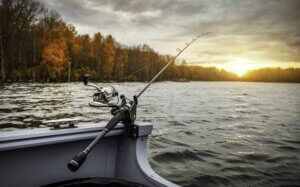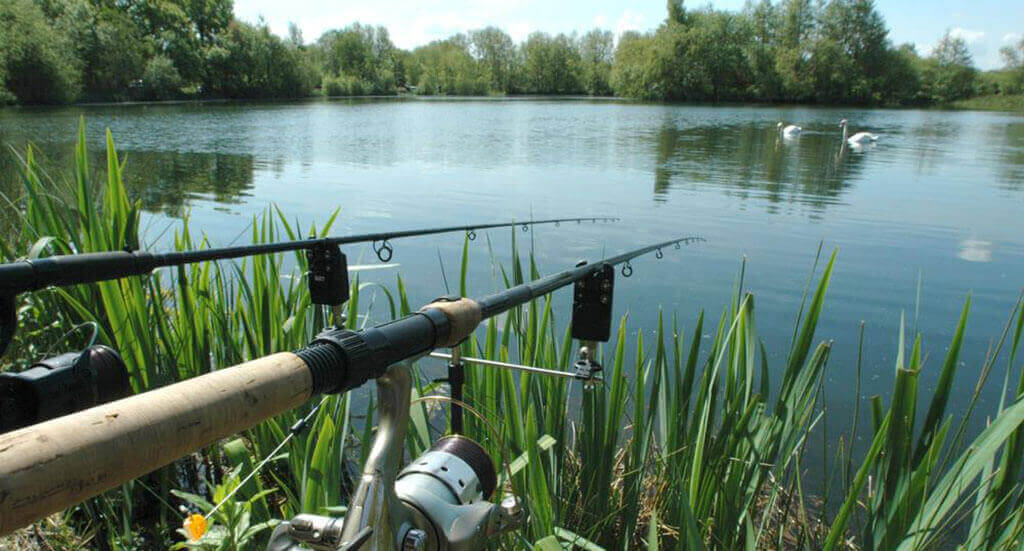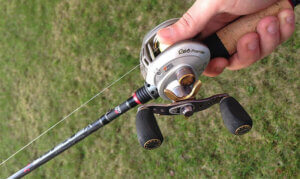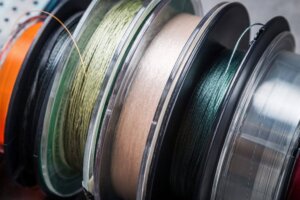
Lakes are freshwater bodies. They are found naturally in ravines and deep in forests. Lakes are known to be relatively shallow as compared to saltwater bodies such as oceans and seas.
Contrary to popular belief, freshwater fishes also have a massive demand in the restaurant industry. This is why freshwater fishing is thriving and is expected to grow in the coming years.
If you want to get into the freshwater fishery business or spend time with your family at a lake, you should learn the techniques required to handle the fishing equipment.
Before you go to a lake, you need to learn how to set up a fishing rod for lake fishing.
Please buy the equipment separately instead of purchasing a pre-built configuration. This way, you can make a setup that completely fulfills your requirements.
Fishing in shallow waters is not as easy as professionals make it look. It takes practice to catch fish in a lake, even though most lakes are relatively shallow. Freshwater fish are docile, but some fish do put up a fight.
As a beginner, you cannot just go to a lake with your equipment and expect to catch a fish on your first try.
First, you need to know what your equipment is capable of and what its limitations are.
The first step to becoming a good fisherman is to buy suitable equipment that fits your needs. The necessary components of any fishing equipment are given below:
- Fishing rod
- Baitcasting reel
- Fishing line
These three components are the minimum requirements for the assembly of a fishing rod capable of catching fish in a lake.
You can buy these components separately and assemble them yourself, or you could have a professional do it for you.
However, if you genuinely want to learn how to set up a fishing rod for lake fishing, you need to know how to do this yourself.
Let’s discuss the type of equipment needed and the features that are best suited for lake fishing.
Equipment Needed for Lake Fishing
Fishing Rod
You can’t have a fishing set up without a fishing rod. A fishing rod is an extended piece of strong material that can withstand large amounts of force.
A fishing rod should be sturdy enough to handle the weight of the fish you intend to catch and flexible sufficient to assist you in casting your fishing line.
There are multiple types of fishing rods that you can buy from fishing-equipment stores.
The materials they are made from range from plastic to metal. There is some composite and carbon material also.
Each material has different benefits. Some materials are more rigid, whereas some are more flexible.
There some that are the best of both worlds but can be expensive.
Rigid Rods
Rigid does not necessarily refer to the rod being completely inflexible. Many elongated materials have a high ductility ratio and can bend at specific angles without permanent stress.
In this category, the types of materials used are metals.
Metals are strong materials that can withstand a lot of weight when a fish is pulled from the water. There are mainly two types of metals that are used for fishing rods: aluminum and stainless steel.
- Aluminum
Aluminum is a strong metal that can survive high-stress situations and pull fish out of the water without bending permanently.
However, being a metal, aluminum is susceptible to corrosion, and it might have to be replaced after a couple of dozen lake-fishing trips.
- Stainless steel
Stainless steel is the best metal fishing rod available on the market. It is immune to rust and can pull heavier fish out of the water without any permanent bending marks.
It is durable and does not snap under intense pressure.
Flexible Rods

This category of rods consists of plastic composites and other lightweight materials such as carbon. These types of rods are more useful for catching lighter fish.
They are also easy to handle since this setup is relatively lighter than a metal setup.
The materials that can be used for making flexible rods are explained below.
- Plastic composites
Plastic is one of the most useful materials on the planet. It is known to be able to withstand the stress that is multiple times its own total weight.
Plastic is best suited for smaller fish since it might snap under too much force if a larger fish gets hooked onto the line.
Plastic is light and cheap, but it lacks metal’s structural integrity and can fail if you apply too much force to it.
- Carbon
Carbon is a widely-used material in fishing setups. It is used to design many components of fishing setups.
A carbon fishing rod is lightweight, just like plastic, and it also possesses the structural integrity of metals.
This best-of-all-worlds implementation is very beneficial for beginners since it is safer to use.
A carbon rod will not snap easily if it is pushed to the limits. Simultaneously, its lighter weight gives the user an advantage since it is easier to handle.
If you are using a carbon rod, you will need a heavier fishing lure. There has to be something heavy in your rod setup that can give the line enough momentum to reach further distances.
In a metal rod, the heavier materials such as aluminum or steel provide enough momentum on their own. This is why a lighter lure is preferred in such a case.
Baitcasting Reel
If you’re fishing on a lake, you’re going to need quality fishing reels that can protect your internal gears from the water around you. The gears of your reel are the primary operating parts of your entire setup.
Most gears are made of brass. These parts are protected using a strong housing frame made of metal, carbon, plastic composite, or graphite.
These materials ensure that water does not reach the internal gear system since water can ruin its operation.
If you are going to fish in lakes, you are going to want to set your priorities. You need to decide if you want to make a one-time investment and buy a high-quality reel or a midrange/affordable reel that might lack a few features.
Baitcasting Reel Features for Lake Fishing

Some of the most important features you need to look out for are endurance, durability, and performance.
- Endurance
Endurance refers to the ability of the reel to withstand extreme conditions for long periods of time. You can’t simply pull out a fish once it is hooked.
A fish will try to swim away, which will put a lot of stress on the reel.
A good-quality reel should be able to last the entire duration of pulling without giving way.
If a reel fails during the pull action, then you might end up damaging the reel and lose the fish. You might totally ruin your entire setup permanently also.
- Durability
A reel should be able to withstand the water’s corrosion-causing properties. Your reel should be able to last long if you choose a metal setup.
In the case of metal, make sure it has a protective coating applied to it or made of stainless steel.
For fishing reels, the primary durability test is that of the housing frame of the reel. It is available in different materials.
There are lightweight materials as well as heavy, rigid, and rust-resistant materials such as steel.
Graphite is another material that can be used for the frame of a baitcasting reel. It is rigid enough to withstand any major shock, and it does not corrode, unlike metals which degrade after heavy use.
- Performance
A reel’s performance is directly dependent on the gear system in the reel (housed inside the frame). The gears are designed to help you pull the fish out of the water without going into the water.
Working alongside these gears are the ball bearings included inside the gear system.
The number of ball bearings corresponds to the physical performance capability of your baitcaster.
A good-quality baitcaster will have at least 7 ball bearings that will allow the user to pull the fishing line out of the lake once the bait is hooked.
There are many online market places where you can find products that fulfill your requirements. Every product has different benefits that can help you in lake fishing.
All you have to do is figure out your requirements, do your research and make an informed decision.
Fishing Lines

Lakes are relatively shallow water bodies. They do not have many fish swimming near the shore, and most of the good catches are somewhere further in the deeper waters. Fish that are found here are also not that big (with a few exceptions).
Basically, you do not have to get high-quantity strands of fishing lines for fishing in a lake. You still need a multi-stranded one, but buying a premium filament fishing line is a little redundant when lake fishing.
There are mainly three types of fishing lines. They are categorized based on the number of strands each line possesses. They are explained as follows:
- A mono-filament design consists of a single-filament fishing line that can handle the pressure from small fishes such as freshwater trout or freshwater salmon. Larger fish of the same species might not be supported by the mono-filament design since it does not have enough physical integrity.
- A thermal-filament design consists of multiple strands of filaments that are bonded together using complex thermal reactions.
- A braided filament contains multiple strands, just like thermal designs, but in this case, the filaments are bonded using braiding techniques. This way, the final fishing line is much sturdier than any other implementation, and it can survive high-stress situations.
Now that you have chosen your equipment, you can begin the assembly of your set up. Try assembling it yourself. This way, you can learn more and actually set yourself on a path to professionalism.
Lake Fishing Permit
After assembling your equipment, you need to find a spot where you can sit back and wait for your line to get hooked.
However, before this, do keep in mind that you need a permit to actually be able to set up your equipment at the chosen spot.
You can get an annual permit from your local government offices at a low cost. The cost of a fishing permit ranges from around $40-$110.
This is a minimal price to pay considering it comes down to a couple of dollars per month.
Is a Permit Necessary for Setting Up a Fishing Rod for Lake Fishing?
Yes, a permit is necessary for casting a line for lake fishing. In some states, you might be committing a misdemeanor by fishing without a permit. If you are caught, you might be removed from the premises.
In some cases, authorities can also confiscate your equipment if you are found to be fishing without a permit. All your hard work could go to waste.
As such, every time you go to the lake, you must have your permit with you as proof of purchase.
You can get fishing licenses at convenience stores where fishing equipment is also sold.
These conventional methods are available only in a few areas where you don’t have to go to government offices to get your permit issued.
It all depends on which state you live in, and the laws of your state might vary for different counties.
In some cases, a lake might be split into two states, so you will need to determine which side you are fishing on.
Where to Set Up a Fishing Rod for Lake Fishing?
There are different areas in a lake, and you can find different types of fish swimming in each area. It is best if you try to find a relatively deep area.
This is because larger fish avoid shallow waters and prefer to live in such open areas.
Along the shore
The shore is a good place to start your fishing experience if you are a complete beginner.
The fish you might catch in these areas are relatively small since the base is shallow and large fish do not come this close to land.
You could try and cast your baitcaster further from the shore to reach deeper waters where the big fish can be found.
However, it is impossible in a lake to tell which area is deep when you are at the shore.
On the water
If you want to catch the bigger fish, you need to go out into the open water in a boat and cast your fishing line wherever you can see a deep grove.
A deep grove refers to deeper waters where you will find larger fish than the fish you find in the shallows.
Setting Up Equipment for Lake Fishing
Once you have decided where you are going to fish, you need to start setting up your equipment. There are mainly two options. You can do the setup at the shoreline or in the water (on the boat).

Shoreline setup
Before setting the rod in the ground, you need to cast the fishing line into the water. You can either cast it in the shallows, or you can cast it further into the water.
Just put the bait onto the hook and cast it into the water. Now you have to set the rod and wait patiently.
To prepare for a shoreline set up, you need to have an amount to place your fishing rod.
You can either separately buy this mount or dig in your rod into the dirt to support it so that it stands while the hooked bait is in the water.
You can dig the hole using the rod itself if it is a structurally strong rod, or use rocks to support the rod so that it stands.
In-water setup
For this, you will obviously need a boat or a kayak. You can either use a simple boat, or you can use one that is specifically designed for fishing in lakes.
Some kayaks have a built-in stand for your fishing rod, so you can place it there once you cast out the fishing line.
After you have baited your hook and cast it in the water, you can relax in your kayak and enjoy the view while your rod rests on the included mount.
If a fish gets hooked onto the line, your reel will alert you, and you can pull out the fish.
